Like Harry Potter’s? 3D 'invisibility cloak' unveiled by NY scientists (VIDEO)

A news ‘invisibility’ cloaking device has been unveiled by US scientists – which they say can be constructed at home, causes no distortion of objects in the background, and can conceal objects in 3D from different angles.
Scientists from upstate New York’s University of Rochester have
managed to create the device, which looks like a set of
optometrist’s equipment and can bend light around the “cloaked”
object so that it appears invisible.
The lenses used in the process are easily obtainable and
inexpensive. However, while “cloaking” the object, it is not
currently in cloaked form, and remains a series of layered lenses
which makes the object placed behind appear as if it is not
there.
“A lot of people have worked on a lot of different aspects of
optical cloaking for years,” said John Howell, a professor
of physics at the institution.
“From what we know, this is the first cloaking device that
provides three-dimensional, continuously multidirectional
cloaking,” added graduate student Joseph Choi.
Previous projects working on concealing objects with
“invisibility” have had limitations in that the illusion
only works at a certain angle. Previous methods have also been
far more complex and expensive.
The tests have seen the scientists hide a hand, someone’s face
and a ruler. However, one limitation to the device is that it is
objects on the edges of the lenses that remain out of sight,
whereas those directly in the middle may still be at least
partially seen.
However, the scientists maintain that the possibilities as a
result of the device’s development are endless.
“I imagine this could be used to cloak a trailer on the back
of a semi-truck so the driver can see directly behind him,”
Choi said. “It can be used for surgery, in the military, in
interior design, art.” As with the “Harry Potter”
invisibility cloak, no distortion of background objects occurs.
In February 2013, an “invisibility cloak” was developed and
displayed at a US tech conference by Dr. Baile Zhang, an
assistant professor of physics at Nanyang Technological
University in Singapore. However, it didn’t work from various
angles.
Scientists at London’s Imperial College, Duke University and the
University of Texas have also been working on similar designs.
Scientists for the first time succeeded in “cloaking” an object
in 2006, after which the Imperial College researchers laid out
their theory for others to copy.
In 2011, a physicist at the University of Texas Dallas
successfully created a small invention that uses carbon nanotubes
to make objects behind it disappear. At Duke, inventors used
meta-materials to create a tiny cylinder that bends
electromagnetic waves and makes objects vanish.














